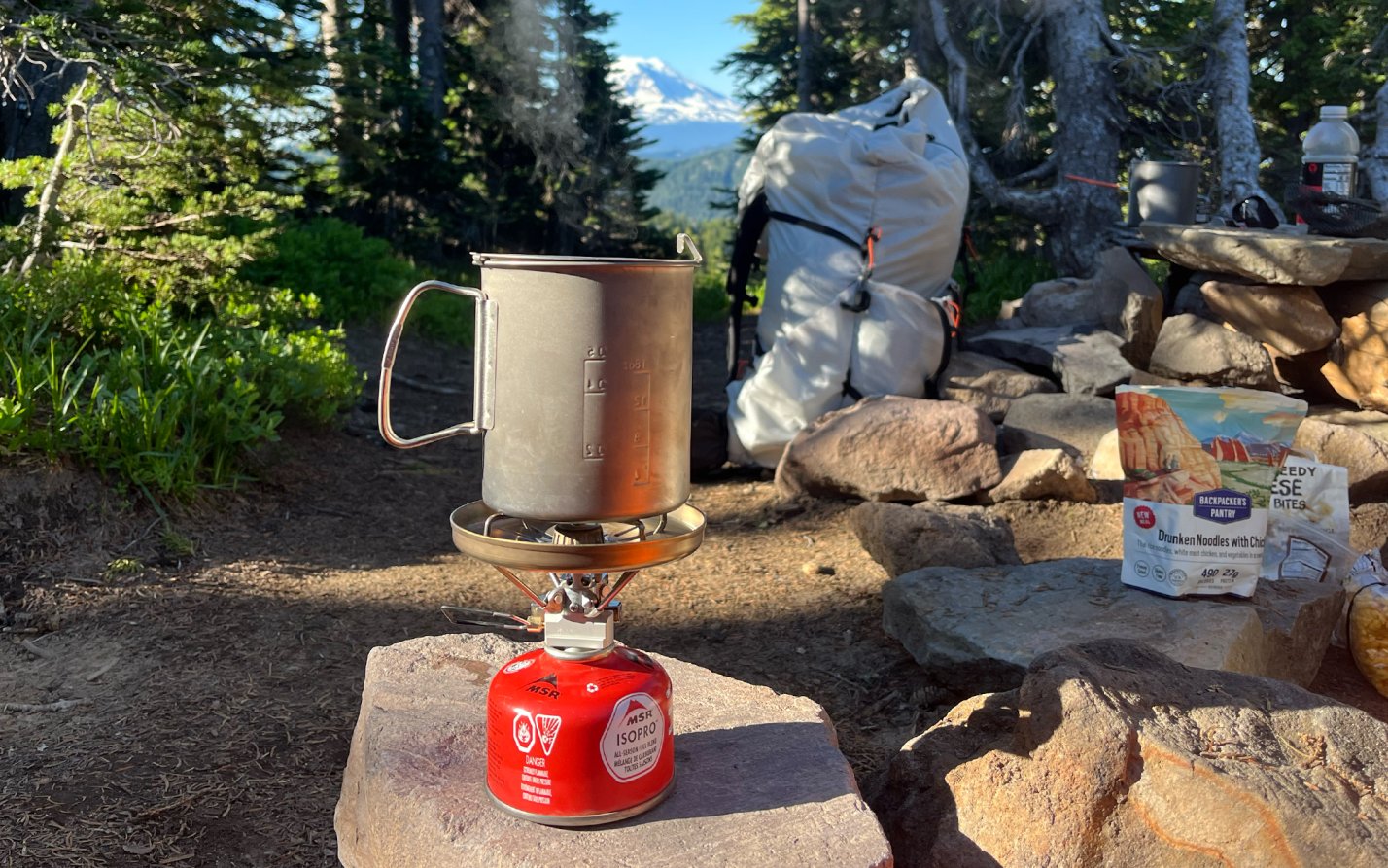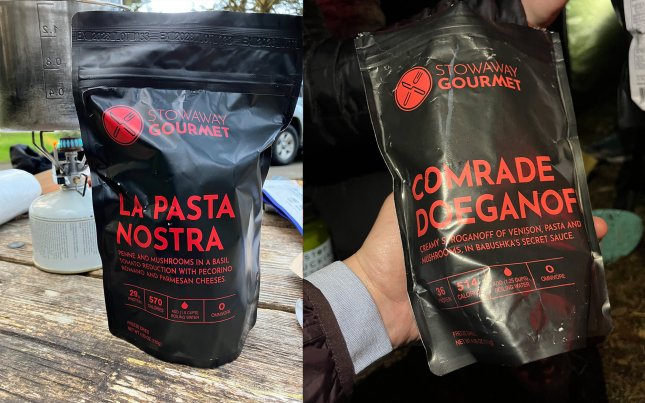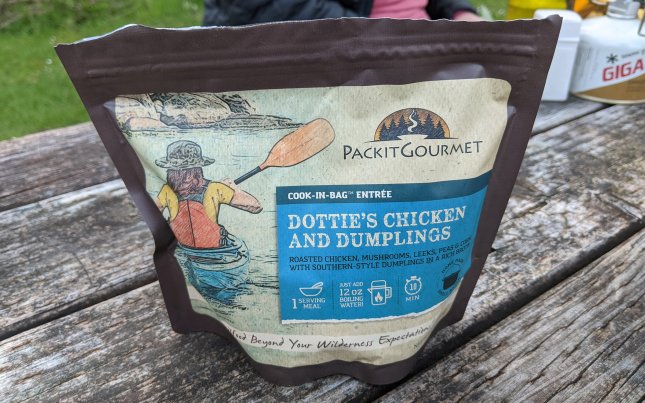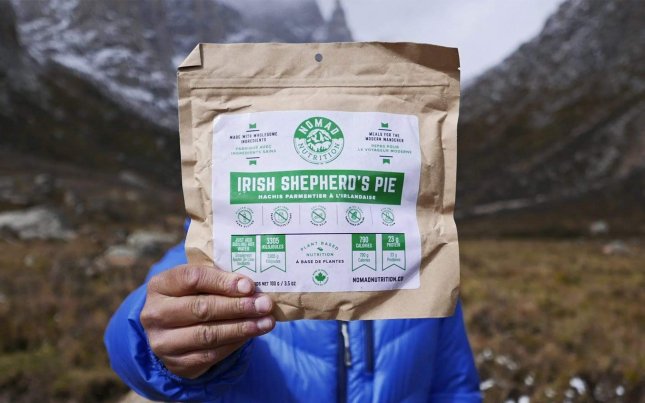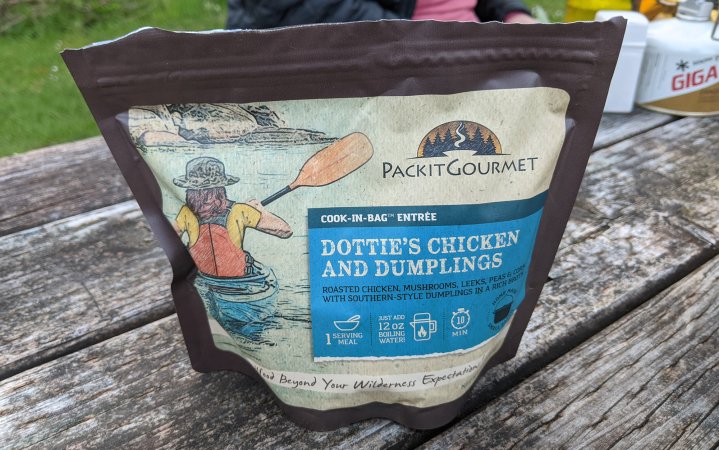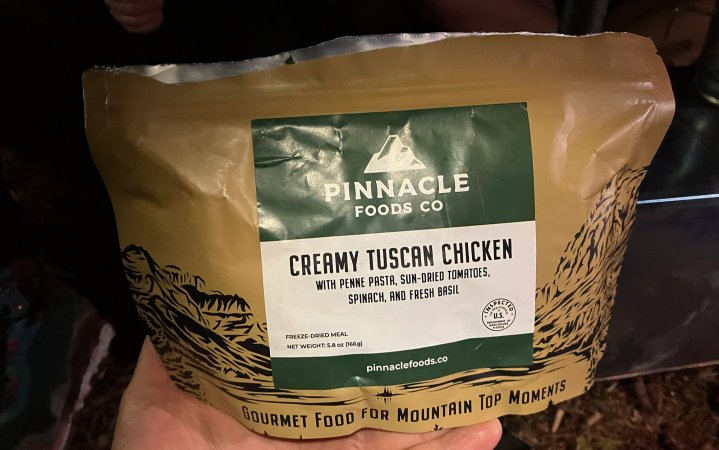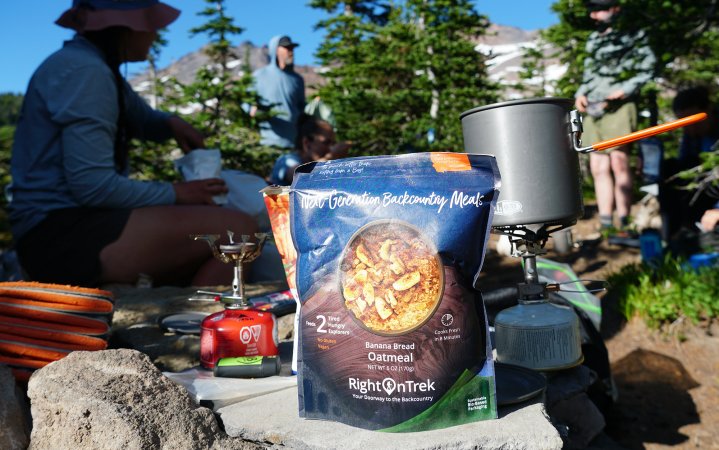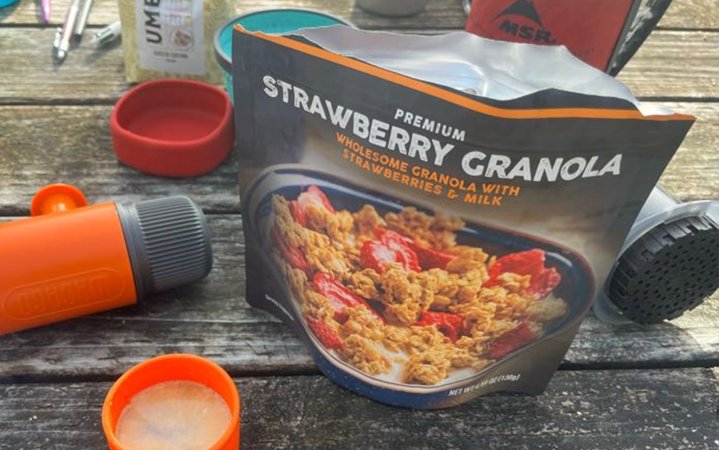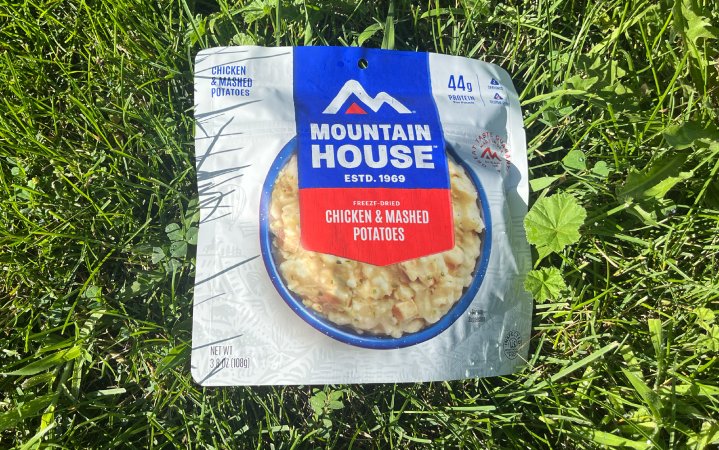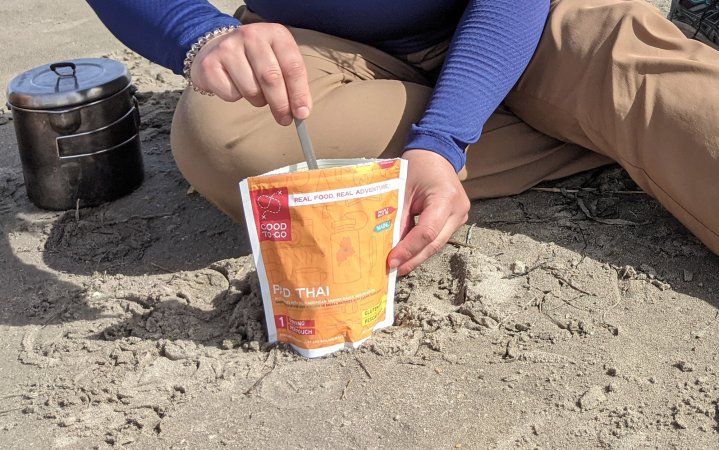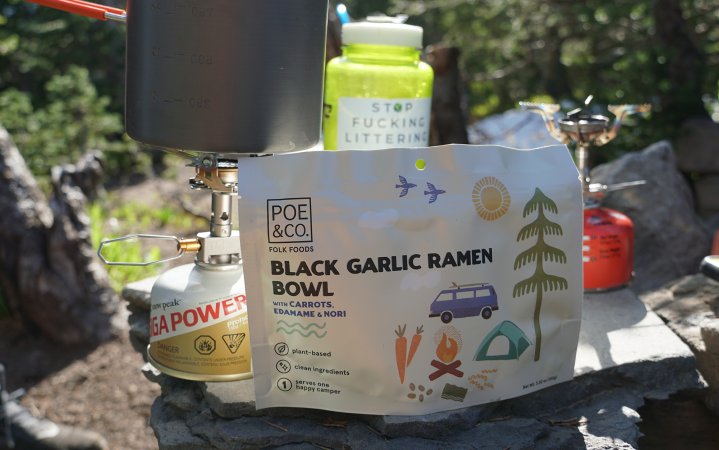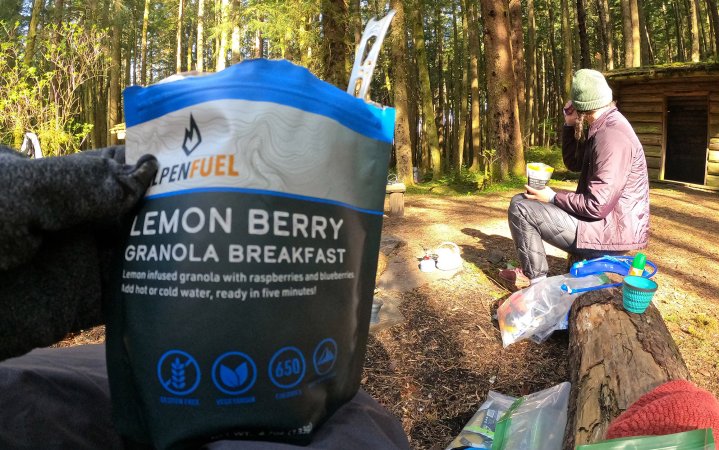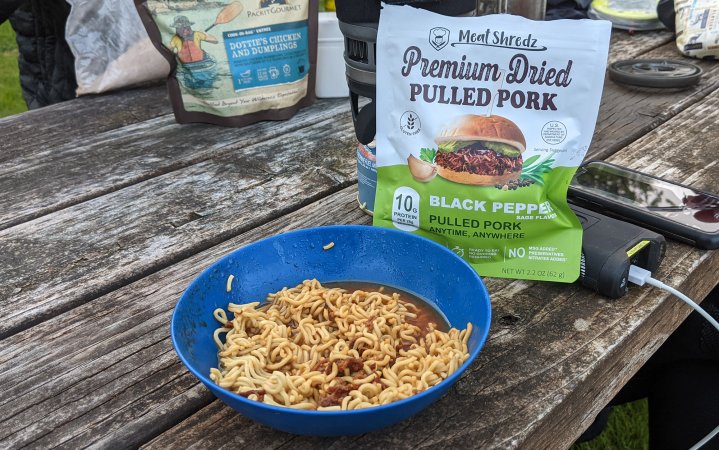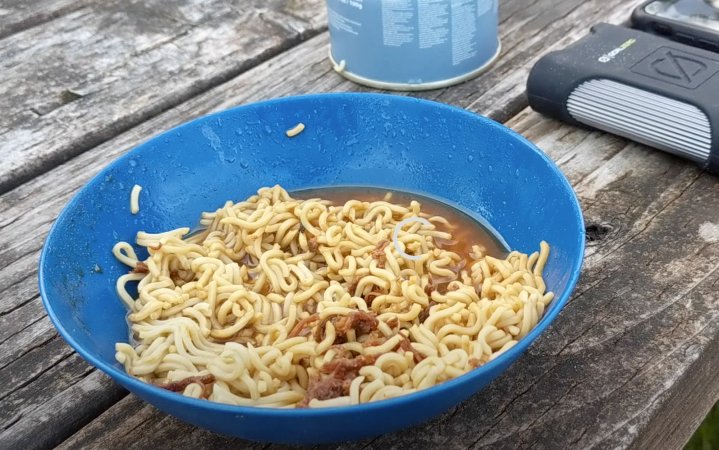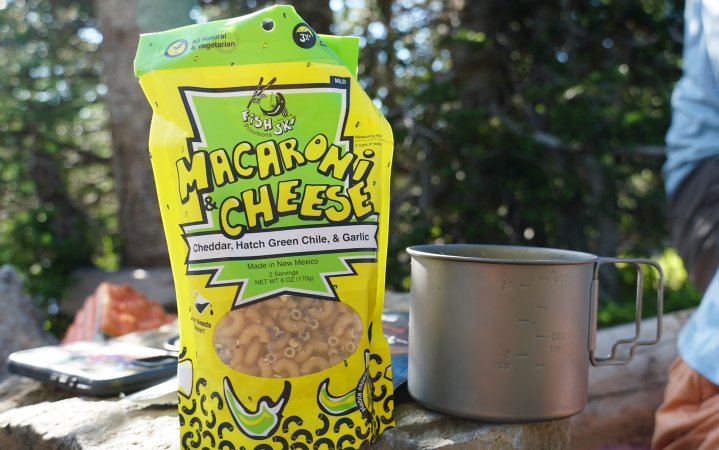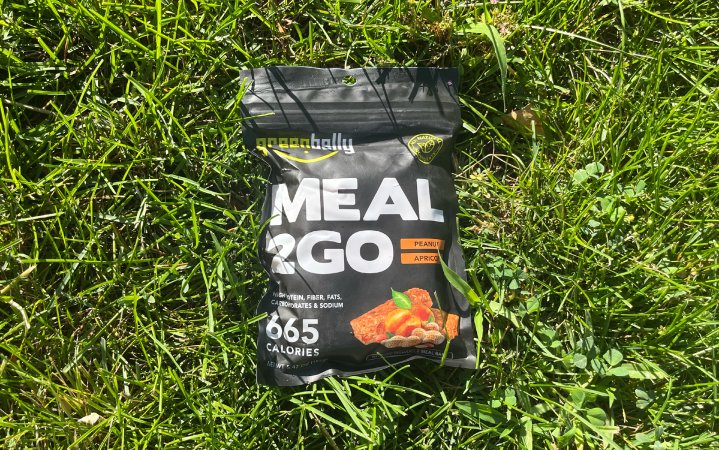We may earn revenue from the products available on this page and participate in affiliate programs. Learn More ›
“If you had to eat one more dehydrated backpacking meal, which would you pick?” Collective groans from my panel of testers ensued.
After three days of eating nothing but freeze-dried or dehydrated food, assessing them for weight, taste, caloric density, and how they made our bodies feel, we’d had enough. But we also had plenty of opinions about which of the best backpacking food brands we’d take with us into the field again. And then we promptly ordered burgers and fries.
Backpacking foods are freeze-dried or dehydrated meals that are lightweight and shelf-stable for long trips into the backcountry, which can make them less tasty and harder to digest than a fresh meal. But, there are companies making delicious and nutritious backpacking meals. Seven backpackers tested them all — good and bad — and rated them on preparation, taste, nutritional value, and how they made us feel. Here are our picks for the best backpacking food listed in order of how highly we recommend them:
Best Backpacking Meals
- Best Tasting: Stowaway Gourmet
- Best Value: Packit Gourmet
- Pinnacle Foods
- Right on Trek
- Peak Refuel
- Backpacker’s Pantry
- Mountain House
Best Backpacking Meals for Dietary Restrictions
- Best Vegan: Nomad Nutrition
- Best Gluten-Free: Good to Go
- Heather’s Choice
- Poe & Co. Folk Foods
Best Specialty Backpacking Food
- Granola: Alpen Fuel
- Protein: Meat Shredz Premium Dried Pulled Pork
- Ramen: Immi
- Mac and Cheese: FishSki Provisions
- Meal Replacement: Greenbelly Meals
| Our Top 7 Favorite Entrees | Calorie Ratio | Protein | Sodium | Cook Time | Water | Enthusiasm | Price |
| Stowaway Gourmet Lamb Bourguignon | 176.25 | 36 grams | 1,424 milligrams | 10 minutes | 1.25 cups | 5 | $19.95 |
| Pinnacle Foods Italian Sausage and Zesty Tomato Sauce with Farfalle Pasta, and Parmesan | 163.27 | 38 grams | 1,570 milligrams | 12 minutes | 1.5 cups | 4 | $15.99 |
| Packit Gourmet Curry Mango Chicken Salad | 134.38 | 40 grams | 470 milligrams | 15 minutes | 5 ounces | 5 | $12.99 |
| Backpacker’s Pantry Fettucini Alfredo with Chicken | 116 | 40 grams | 1,450 milligrams | 15 minutes | 1.5 cups | 3 | $12.99 |
| Good to Go Chicken Pho (double serving) | 116.42 | 53 grams | 2,430 milligrams | 10 minutes | 1.5 cups | 3 | $15.50 |
| Peak Refuel Chicken Pesto Pasta | 161.12 | 43 grams | 900 milligrams | 10 minutes | 5 ounces | 3 | $13.99 |
| Right on Trek Chicken Coconut Curry (double serving) | 122.2 | 44 grams | 1,210 milligrams | Boil for 3 minutes | 2.5 cups | 4 | $16.49 |
Enthusiasm is a cumulative score of taste and post meal feel.
How We Tested the Best Backpacking Food

Outdoor Life testers ate all of these meals on our annual backpacking gear tests. These testing trips take place on America’s national scenic trails, including a 30-mile stretch of the northernmost section of the Oregon Coast Trail and a 40-mile stretch along the Pacific Crest Trail in the Goat Rocks Wilderness.
On the Oregon Coast Trail, five testers ate backpacking food for eight meals straight over the span of four days. Organizer Laura “Chop Chop” Lancaster asked our resident dehydrated food expert, OL contributor Patrice “Steady” La Vigne, if three freeze-dried meals a day was too much to ask of people. Steady cheerily assured her, “The food is great now. It’ll be fine!”
Reader, it was not fine. While the backpacking food we tested was mostly tasty, the consequences of eating heavy, sodium-laden, dehydrated food three meals a day became apparent very quickly. So in the Goat Rocks Wilderness we scaled back our seven testers to one or two meals a day. This proved to be an appropriate amount of dehydrated food, providing plenty of flavor and convenience without compromising our ability to digest food.
Testers
- Alex Robinson: OL editor-in-chief; a backcountry big game hunter
- Ashley Thess: OL associate gear editor. Over 600 miles of backpacking experience.
- Diana Helmuth: Author of How to Suffer Outside (National Outdoor Book Award winner). Over 1,500 miles of backpacking experience.
- Jac “Top Shelf” Mitchel: Over 11,000 miles of backpacking experience including the PCT 2014, CDT 2016, AZT, 2017, and GET 2017.
- Laura “Chop Chop” Lancaster: OL staff writer. Over 4,000 miles of backpacking experience, including the PCT 2014 and CT 2017.
- Patrice “Steady” La Vigne: Gear reviewer, Denali guide, and author of Between Each Step. Over 7,000 miles of backpacking experience, including the AT 2011 and Te Araroa 2014-2015.
- Sven “Magic” Anderson: 1,350-mile LASH (PCT) 2022. Hiking with Parkinson’s disease.
How We Graded the Best Backpacking Food

We evaluated each meal on the following criteria:
- Preparation (How easy is the meal to prepare?)
- Taste (Is this something we want to eat after a long hike?)
- Nutritional Value (We checked the ingredients and the nutritional facts to see if the meals have the proper balance for backpacking.)
- Post-Meal Feel (How did we feel after eating the meal?)
Preparation includes the required amount of water, cook time, and how well the meal rehydrated. We used a combination of taste and post-meal feel to create an enthusiasm score reflected in our top seven entrees table. It shows how excited we would be to eat this meal again on a 1 to 5 scale. The nutritional value of each meal includes sodium, protein, fiber, calorie, and nutrient contents.
Best Backpacking Meals: Reviews & Recommendations
Best Tasting: Stowaway Gourmet
Pros
- Tastes like fine dining at a five star restaurant
- Lightweight
- Unique
Cons
- Expensive
Key Features
- Price: $16.95 to $19.95
- Shelf Life: 5 years
- Net Weight: 3.4 to 5.2 ounces
- Protein: 12 to 43 grams
- Calories: 435 to 704
These backpacking meals are indeed gourmet. With favorites like Lamb Bourguignon and Comrade Doeganoff, we were thrilled to indulge in these delicious and filling entrees. The lamb included sweet potato chunks and a red wine reduction. The Doeganoff had large pieces of venison and a creamy consistency. I think the unique protein choices like venison, wild boar, and bison give Stowaway Gourmet an edge, too. Besides protein they also replenish your iron levels which can deplete during endurance activities. The meat chunks are sizable and make you feel like you’re eating a home-cooked meal, which you are, just a freeze-dried one.

The cook time is just 10 minutes, if stirred properly, so you can enjoy your dinner sooner than others on this list. Stowaway Gourmet meals are decadent and filling, but nutritious with a respectable amount of sodium, around 33 percent of your daily value. If you’re headed to a spectacular vista or introducing someone to the backcountry, these are a great idea. However, with the rich flavors and $20 price tag, these might not suit you for breakfast, lunch, and dinner everyday. It is also listed as two serving sizes, but trust me, these are too good to share.
Best Value: Packit Gourmet
Pros
- Made us feel like mom packed a homemade meal for the trail
- Creative
Cons
- Takes a while
Key Features
- Average Entree Price: $14
- Shelf Life: 18 months
- Net Weight: 3.2 to 7.4 ounces
- Protein: 23 to 50
- Calories: 370 to 800


The creativity and attention to detail in these meals is amazing. The Mango Curry Chicken Salad tastes like it’s from a deli and the All-American Burger Works was a fan favorite. Both include a separate bag containing condiment packets and are made of the ingredients and flavors we actually crave on trail. Think about the amount of times you wanted a fresh salad for lunch or craved a burger on trail. And since Packit Gourmet uses whole, quality ingredients, the nutritional value is comparable to the real thing.

Packit Gourmet also sells a Happy Hour Queso Rico Dip and Happy Hour Pico de Gallo that were tasty and unique. Celebrating happy hour on trail with treats like these is a real morale boost. I would recommend heating the queso in a pot because it cools off too much in the bag as it rehydrates. The salsa looked and tasted like real salsa. Both bags were difficult to get chips in and out of though.
Pinnacle Foods
Cons
- High sodium
Key Features
- Price: $16
- Shelf Life: 1 year (Omnidegradable bags) or 5 years (retort bag)
- Net Weight: 3.5 to 5.1 ounces
- Protein: 25 to 53 grams
- Calories: 550 to 850
Pro
- Reminded us of our favorite frozen Trader Joe’s meals
- Biodegradable bag option
- Short bag option
If Stowaway Gourmet is restaurant food quality, Pinnacle is Trader Joe’s quality, which tastes like a delicious treat in the backcountry. The Italian Sausage and Zesty Tomato Sauce with Farfalle Pasta, and Parmesan was a perfectly filling meal and tasted like a weeknight dinner I might make for myself at home. However, the sodium was 68 percent of the daily value. I had the Jalapeno Cheddar Biscuits and Herbed Sausage Gravy for breakfast and while it was also delicious, it was 55 percent of my daily sodium intake, meaning I was topped out after two meals. Some of the biscuits stayed crispy for a welcome texture change; I only wish it had more jalapeno as the spice was very mild.

Pinnacle backpacking food is sold in either the Omnidegradable bags or the retort bags. The Omnidegradable version is compostable, making it great for the environment but less capable of preserving its contents; these meals are only good for a year. The Retort bags aren’t compostable, meaning they are more rugged and able to stand up to poor conditions on a long trip. These bags are also wide and shallow allowing for better access with a normal length spork making preparation easier so you can properly stir.
Right on Trek
Pros
- Delicious dinners
- Good value
Cons
- Shorter shelf life
- Should be cooked in a pot
Key Features
- Average Entree Price: $10
- Shelf Life: 18 to 30 months
- Net Weight: 6.4 to 10.6 ounces
- Protein: 22 to 32 grams per serving
Right on Trek was hands down the fan favorite of the 2024 best backpacking food test. Helmuth exclaimed, “Where have you been all my life?” after eating a two-person serving of the chicken coconut curry on her own. While it took her a while to finish the whole thing, I was able to house the entire two-person broccoli beef stroganoff in one sitting. I loved biting into actual chunks of broccoli, and the whopping 64 grams of protein.
These meals are designed to be cooked in a pot on a stove, not in the bag. This didn’t bother me in the slightest, but you will need a pot with the capacity to hold the entire contents. Some testers had pots that were too small to fit two servings, and decided to pour boiling water directly into the bag. Nothing bad happened to them and their meals cooked just fine, but I wouldn’t recommend this course of action and neither does Right on Trek.
However, I think heating it up in a pot is ingenious. Your food actually cooks instead of partially rehydrating into mush and crunchy bits. It also eliminates the threat of powdery, under stirred corners of a bagged meal. If you have digestive problems with backpacking meals, one possible culprit is that they aren’t completely rehydrated when you eat them, so they rehydrate in your stomach, causing issues.
The Right on Trek meals were also ready the fastest in just 5 to 10 minutes, and they’re hot off the stove instead of lukewarm after sitting out for 15 minutes. If you have a Jet Boil or tiny pot, you’ll have to make adjustments to your kit to enjoy these meals, but we were big fans of the entrees we tried.
I’m always skeptical of backpacking food companies selling oatmeal, because it better be 10 times better than an instant pouch from the grocery store if it costs 10 times as much. We were swayed by the promise of Right on Trek’s banana bread oatmeal, but were left disappointed and wanting to re-brush our teeth. Something in this dish felt filmy and the flavors weren’t there.
Peak Refuel
Pros
- Feels like eating at a local diner
- High-calorie
Cons
- Took more time to rehydrate than stated
Key Features
- Price: $14
- Shelf Life: 5 years
- Net Weight: 4.59 to 6.77 ounces
- Protein: 13 to 53 grams
- Calories: 530 to 1,100
The Peak Refuel meals taste great and include a lot of real meat. These calorie- and protein-dense meals are designed for two people but after hiking for 19 miles I easily ate the entire Chicken Pesto Pasta by myself. I would recommend these for big days when you want a hearty refuel, as the name suggests. The Biscuits and Sausage Gravy makes a highly filling and meaty breakfast to fuel a long day or as an indulgence later in your trip.
We did run into an issue where these meals took longer to rehydrate than the package stated. While it doesn’t sound like a big deal now, wait until you’re starving and counting down the seconds to dinner time. However if you’re looking for performance comfort food, Peak Refuel is ideal. But just like real diner food, these meals are very high in sodium. But they kept people full until the next meal.
Backpacker’s Pantry
Pros
- High-calorie
- Good price point
- Easy to find in retail stores
Cons
- Hit or miss flavors
Key Features
- Price: $10
- Shelf Life: 3 to 10 years
- Net Weight: 2.3 to 6.7 ounces
- Protein: 13 to 41 grams
- Calories: 300 to 820
While a lot of these meals are online only or sold in specific retail locations, Backpacker’s Pantry is stocked at REI and ranges from $7 to $13. The meals list the serving size as two, which may be accurate for relaxed days, but if you’re hiking a lot it’s easy to eat the entire package yourself. If it’s your first time eating Backpacker’s Pantry, play it safe and assume everyone will need their own meal.

As far as taste goes, the food can be hit or miss. While international flavors abound in backpacking food, when it comes to Backpacker’s Pantry I would recommend sticking with the Western classics like the Three Cheese Mac and Cheese and Lasagna. The seasoning in the Pad Thai and Chicken Larb are off and don’t taste as good. The Pad Thai didn’t taste like Pad Thai, just nondescript Asian noodles with unpleasantly funky flavor. The Chicken Larb was overwhelmingly seasoned, especially with mint giving the impression that you’re eating ground chicken mixed with toothpaste.
The sodium levels in Backpacker’s Pantry vary with some meals containing as much as 1,750 milligrams. The prep time is reasonable and recommends stirring halfway through which I think helps make sure the entire meal rehydrates. With a lot of calories and protein, these are good for replenishing after a long day on the trail.
Mountain House
Pros
- Easy to find
- Easy to rehydrate
Cons
- Tastes like a frozen TV dinner
- Not enough for two people
Key Features
- Price: $11 to 12
- Shelf Life: 30 years
- Net Weight: 3.3 to 5.5 ounces
- Protein: 12 to 22 grams
Mountain House is certainly the most readily available freeze-dried meal brand. You can find them at grocery stores, sports stores, Walmart, REI, and more. They’re also rather polarizing. While I wouldn’t feed this to a stray cat, Top Shelf appreciated the salty, fatty diner-style flavors. She thinks they’re pretty foolproof to make; even if you’re half awake you can slough some hot water in the bag and it’ll rehydrate just fine. Though, she does recommend adding hot sauce.
Our resident freeze-dried-food-expert, La Vigne, thinks they are “fine.” Magic couldn’t finish a whole one, and after tasting La Vigne’s chicken tikka masala, I’d rather go hungry than eat one, too. Everyone’s spectrum of inedible is different, but if you’re in charge of food on your next adventure, don’t expect to be the most popular person at camp if you bring a load of Mountain House meals.
Best Backpacking Meals for Dietary Restrictions: Reviews & Recommendations
Best Vegan: Nomad Nutrition
Pros
- Hearty and unique flavors
- Vegan
- Gluten-free
Cons
- Took a little longer to rehydrate
Key Features
- Price: $14
- Shelf Life: 26 months
- Net Weight: 4 ounces
- Protein: 9 to 22 grams
Helmuth had the Irish shepherd’s pie for her last dinner and reveled in the whole ingredients; she was especially excited about the sun dried tomatoes sprinkled in. “High in potassium and iron and low in sodium, that’s the nutrition I need, not a sodium bomb with a vitamin thrown in,” she said. She felt full after eating the entire meal, but did have room for dessert after.
Chop Chop thought the California breakfast bowl was nourishing without being overwhelming first thing in the morning. With unique and satisfying flavors like Ukrainian borscht and Caribbean curry, this plant-based meal option uses hearty grains, vegetables, and naturally protein-rich foods. Only the new Southwest breakfast skillet uses a vegan meat alternative.
Best Gluten-Free: Good to Go
Pros
- Lower sodium
- Gluten-free
- Vegan and vegetarian options
- Kinder on the digestive tract than other options
Cons
- Some are bland
- Not calorie-dense
Key Features
- Price: $8.60 (single serving) $15.50 (double serving)
- Shelf Life: 4 to 5 years
- Net Weight: 4.9 to 6.7 ounces
- Protein: 13 to 16 grams per serving
- Calories: 350 to 540 per serving
Good to Go meals are preservative-free, gluten-free, and lower in sodium. Some can also be rather bland. But this means that Good to Go meals were easier to digest than others. The Good to Go options weren’t the best tasting, but they don’t make you uncomfortable afterwards. There are also a lot of vegan, vegetarian, and pescatarian options. All Good to Go meals are gluten-free so if you have a sensitivity or intolerance, you won’t have to worry about grabbing the right bag or someone eating the only gluten-free option. These should be stirred thoroughly to dig the seasoning off the bottom.

The calories and protein aren’t as high as other meals so I wouldn’t rely on just one serving after a long day. The Chicken Pho was a nice soup option, but OL staff writer Laura Lancaster had another meal as well to feel full. I split the Backpacker’s Pantry Three Cheese Mac and Cheese and the Good to Go single-serving Thai Curry with one tester for lunch on our longest day and it shows how backpacking food serving sizes can’t be trusted. Two people were only full after splitting technically three servings. So Backpacker’s Pantry isn’t enough for two people and Good to Go’s single-serving isn’t enough for one.
Heather’s Choice
Pros
- Comforting flavors
- Satisfying ingredients
- Lightweight
- Vegan, dairy-free, and gluten-free options
Cons
- Takes 20 minutes to rehydrate
Key Features
- Price: $16 ($13 for vegetarian)
- Shelf Life: Two years
- Net Weight: 4 ounces
- Protein: 23 to 44 grams
These just-add-water meals are made with whole ingredients that make you feel nourished after a long day of hiking. Top Shelf raved about the spinach curry with chicken and rice and Chop Chop loved her mole sauce with chicken and rice. While these two meals rehydrated well, my lentil soup was still a bit crunchy after 25 minutes. It was also lacking spice and flavor.
We loved the line on the bag indicating how high to fill it, but 20 minutes is a long time to wait for your dinner when you’re starving. All of the meals are for one person, which is an accurate serving size. Topshelf and Chop Chop felt full after their meals. I was turned off by the texture and didn’t finish mine, but I likely would have been full, too.
My favorite part of the Heather’s Choice bagged meals is that they’re small, lightweight, and packable. You can even get away with eating them without an extra long spork.
Poe & Co. Folk Foods
Pros
- Tastes like lunch from the Whole Foods hot bar
- Vegan
- Gluten-free options
Cons
- Not enough protein or calories for a post-hiking dinner
- Top of the bag tore easily so it couldn’t be reclosed
Key Features
- Price: $12
- Shelf Life: Two years
- Net Weight: 3.5 ounces
- Protein: 5 to 7 grams
If you’re looking for a hot lunch on trail — and you’re not in a hurry — the plant-based meals from Poe & Co. could be a great option. Chop Chop and I enjoyed the coconut chickpea stew, but at only 390 calories and 6 grams of protein, we both ate another dinner. Both of our bags also ripped at the closure so we couldn’t reseal them to retain heat during rehydration or use it as a trash bag.
Alex Robinson thought the black garlic ramen bowl was flavorful with a touch of spice, but it wasn’t near enough food for one hungry dude. The chopped noodles made this chunky soup hard to eat with a standard backpacking spoon. These meals could make a nice appetizer, but they take 20 minutes to rehydrate so more likely you’ll want to eat this for lunch or as a post-dinner snack.
The bags list some suggested add-ons to elevate your meal. For instance, the coconut chickpea stew pairs well with: naan bread, dollop of yogurt, and fresh mint. “I’ll get right on that,” I snorted, crouching in the dirt 30 miles from the closest grocery store. However, if you’re car camping with a cooler, I think these meals doctored up with some additional protein would be a delicious lazy dinner.
Best Specialty Backpacking Food: Reviews & Recommendations
Granola: Alpen Fuel
Pros
- Calorie-dense
- Flavorful
Cons
- Sweet
Key Features
- Price: $9
- Shelf Life: 18 months
- Net Weight: 4.4 to 5.6 ounces
- Protein: 16 to 24 grams
- Calories: 720 to 770
Alpen Fuel makes decadent breakfast granolas that are high in calories, sugar, and flavor. Packaged granola might sound like a scam at first (we were confused). But after eating one, this is above and beyond grocery store granola. Eating these every morning would be too much for me, but if you like a sweet and filling jumpstart to the day, these are perfect. Patrice relished the Chocolate Strawberry Granola Breakfast but the rest of us found it overly sweet. Patrice asked, “Am I the only one that likes chocolate in the morning?” And I think she is. I loved the Caramel Apple Granola, but couldn’t finish it and ended up feeling hungry later.

Alpen Fuel backpacking food has strong flavors, but if you can finish an entire bag, it’ll keep you full and energized for a long time. The high calorie count, protein, and fiber is a nutritional start to a long day. And if you’re going to have a lot of sugar, might as well do it first thing in the morning to get moving. They can be rehydrated cold or hot depending on your mood, the weather, and which flavor you have. For instance, I think the Lemon Berry Granola makes a great cold cereal while the Caramel Apple Granola tasted like apple pie when hot.
Protein: Meat Shredz Premium Dried Pulled Pork
Pros
- Lightweight
- Protein
Cons
- Very dry
Key Features
- Price: $7
- Shelf Life: 1 year
- Net Weight: 2.2 ounces
- Protein: 10 grams
- Calories: 160
As much as we love tuna and chicken packets, sometimes you just need to switch up your protein add-ons. These packets of dried pulled pork are a great way to add extra protein to almost any dish. Immediately I think of adding pulled pork to Packit Gourmet’s queso dip or topping Immi’s high-protein ramen with sriracha pulled pork. Add it to mac and cheese, burritos, and eggs for better meals and a protein boost. The pork is very dry so I wouldn’t snack on it plain. But if you add some bbq sauce and a pickle, I think you could happily spork this out of the package.
One tester tried the Carolina BBQ Shredz on Backpacker’s Pantry Three Cheese Mac and Cheese and Good to Go’s Thai Curry with success, so it seems the options are endless. At under 3 ounces including packaging and at least two servings per package, it’s definitely worth upping your protein in the backcountry with these.
Ramen: Immi
Pros
- Tastes better than Top Ramen
- 21 grams of protein
- 19 grams of dietary fiber
Cons
- Low calorie
- Expensive
Key Features
- Price: $39 for a pack of six
- Shelf Life: 9 months
- Net Weight: 2.4 ounces
- Protein: 21 grams
- Calories: 300
Immi’s ramen is higher in protein, lower in sodium, and tastier than other instant ramen brands. While the package says to boil the noodles for 8 minutes, our testers simply added them to boiling water and turned off the heat to wait, and the noodles cooked just fine. If you’re stopping for lunch on a cold day, this is a great way to warm up.
We also appreciated the 19 grams of dietary fiber as backpacking meals can sometimes twist up your digestive system. If you’re looking for additional protein and fat you could add peanut butter, sesame oil, Meat Shredz Sriracha Pulled Pork, or any other toppings you can think of to make this into a bigger meal. While $6.50 a pop is a little steep, it’s tastier than instant ramen or a protein bar and the customization options are endless.
Mac and Cheese: FishSki Provisions
Pros
- Tastes like home cooked Southwestern cuisine
- Can be made with untreated water
Cons
- Simmer for 5 to 10 minutes
Key Features
- Price: $12 for two
- Shelf Life: Two years
- Net Weight: 6 ounces
- Protein: 8 to 11 grams
Cheesy, protein filled carbs with a touch of spice: In my opinion, it doesn’t get much better than that in the backcountry. Fish Ski Provisions offers southwestern grits and mac and cheese designed for adventures. Starting my day with jalapeño, hatch green chile, cheddar grits and a cup of coffee next to a stream was otherworldly. The grits are accurate when they say two servings; I’d never be able to finish the entire thing.

On the other hand, it was easy to eat the entire bag of mac and cheese in one sitting, and you get 22 grams of protein. While these meals need to be cooked, not just rehydrated, you can use untreated water (boiling water kills biological bacteria and viruses, but it doesn’t remove heavy metals or chemicals). You also don’t have to strain your noodles or grits, because the remaining water interacts with the spice and cheese pouch for the sauce.
The hatch green chili grits and mac and cheese come in just under the ideal 100 calories per ounce ratio, but I felt full and the bags are still highly packable. These are so tasty I’d eat them car camping, in the ski resort parking lot, on a river trip, etc. It’s easy to add even more protein with a Meat Shredz packet or tinned fish (even better, a fresh fish you caught on your trip).
Meal Replacement Bars: Greenbelly Meals
Pros
- Great source of protein and calories
- Nutritional
- Lightweight
Cons
- Dense
- Need to drink water
Key Features
- Price: $8 per meal (15 bars)
- Self Life: One year
- Net Weight: 5.5 ounces
- Protein: 16 to 18 grams
Calling all breakfast-skippers, the Greenbelly meal replacement bars weigh under 6 ounces and have over 600 calories, including the protein, iron, calcium, and potassium your body is craving. Sure, they’re dense. The wrapper politely suggests you “drink with water for best results.” Though Helmuth said the water is non-negotiable. But, I was surprised that the texture wasn’t mealy oats; it’s more akin to a brown rice cake with nuts, oats, and dried fruit mixed in.
There are two bars in each package, and no one finished the entire package in one day. But testers enjoyed the sweet and salty flavor profile. If you’re looking for a fast lunch or breakfast you can eat on the move, these are a great option. The bags are sturdy and rezip so you can keep your other bar at the ready.
Things to Consider Before Buying the Best Backpacking Food

Sodium
The USDA recommends 2,300 milligrams of sodium per day. With sodium counts in the 1,500 milligrams, backpacking meals use extra salt to preserve the food, make it taste better, and replenish your electrolytes. Most people lose between 460 and 1,860 milligrams of sodium per liter of sweat. An hour of vigorous exercise typically makes people sweat 1-3 liters. So while you do need sodium after exercising all day, you can overload. Eating three backpacking meals a day can be too much salt if you are on a more relaxed trip. Common symptoms are increased thirst (which also means you’re carrying more water and taking more bathroom stops), puffiness, and bloating.
Don’t stress about the high sodium levels in backpacking food if you’re hiking a lot, tackling tough terrain, or mixing whole foods into your diet. Your body probably needs it. And if you are worried about consuming too much salt from backpacking food, there are some meals that are lower in sodium than others.
Preparation

To prepare most of these meals, all you have to do is add boiling water and reseal the package until the meal is warm and rehydrated. A few have extras to add in after cooking like a lime or condiment packet.
Some backpacking food requires more time or water to rehydrate than others. Your elevation can also prolong cooking times. Pay attention to the preparation when you’re purchasing so that you aren’t surprised by a 15 to20 minute dinner delay. Also factor the required water into your day’s stash. If you aren’t camping near water, you’ll want to bring extra for cooking.
After eating so many backpacking meals in a row, we developed some pro tips for cooking as well. Stir your bag frequently and intensely; it really makes all the difference. Stir when you add the water, being sure to dredge up the seasonings at the bottom. While it rehydrates in the bag, give the bag a massage. And stir it up again once complete to fluff up your carbs and incorporate all the ingredients.
Most bags don’t have water fill lines so when it says to add a specific amount on the instructions, you might be guesstimating. Try to bring a water bottle, pot, or cup that has measurement markings if you want to be exact. Lots of hikers dive into backpacking food after the recommended time regardless of whether the meal is completely rehydrated or not. Eating crunchy food doesn’t seem so bad when you’re ravenous but it might make your stomach hurt later. Some testers experienced digestion discomfort after consuming semi-raw backpacking food.
Is Backpacking Food Right for You?
While hiking along the 362-mile Oregon Coast Trail, our group ate backpacking meals for breakfast, lunch, and dinner from various brands and sampled most meals. Steady, the only tester who eats backpacking meals regularly, reported that she was feeling fine. Senior staff writer Chop Chop, whose front country nickname is “Lady Garbage Gut,” was also unaffected. The rest of us only treat dehydrated meals as a treat, convenience, or emergency backup. And we were certainly feeling the effects. “I’m not an astronaut; this isn’t in my pay grade,” said Topshelf on the final day of backpacking food testing.
While my digestive tract was tied up in knots, Jac was experiencing the opposite problem. Diana Helmuth experienced perpetual stomach acid and the three of us puffed up in the face, hands, and feet. I couldn’t get my rings off my fingers by morning three. Diana said, “I didn’t know my face could get this puffy.” Once we were relinquished from our testing responsibilities, all five of us celebrated with salads (and pizza sushi).

This is not to deter you from backpacking food in general. If you eat one or two a day, you’ll be perfectly fine. However the increased sodium and still crunchy non-hydrated bits meal after meal are what caused our issues. The meals were mostly tasty and some were easier to digest than others. Dehydrated backpacking meals are convenient, lightweight, and sometimes delicious. So don’t let our suffering be in vain; use the findings in this article to create the best backpacking food plan possible.
Read Next: Best Bear Canisters
FAQs
The best food for backpacking is preserved, tastes good, and is high in protein and calories. You’re burning a lot of calories hiking all day and you need to be refueled by the end of the day. That said, I would not recommend eating backpacking meals for breakfast, lunch, and dinner. Try carrying whole, real, and raw foods if possible, at least for the first day or two. Mixing in these nutritious and fibrous options can save your gut and sanity on trail.
Backpacking food is pricey. There’s no way around it. But you’re paying for convenience. The items on this list range from $8 to $20. Making your own backpacking food can be tricky, though rewarding. So if you want to save time and possibly a disastrous homemade meal or two, buying backpacking meals is safe and easy. Buying in bulk can save you some money, too.
This depends on what kind of wilderness you find yourself in. Your main concerns are bears and rodents. Some wilderness areas mandate a bear canister, but even if they don’t, you might still need it. So call a ranger station or check online about bear activity before you get to your destination. An Opsack or Ursack are odor-proof bags that you can use to discourage mice from visiting your tent in the night.
Final Thoughts
The quality, range, and dietary allowances have grown rapidly in the world of backpacking food. For this list we only included brands that use real food in their backpacking meals. Five testers rotated meals and brands over the course of four days to prepare, eat, and enjoy a variety of the best backpacking food. The findings in this article were drawn from the opinions and favorites painstakingly developed during the Backpacking Gear Test.
Best Backpacking Meals
- Best Tasting: Stowaway Gourmet
- Best Value: Packit Gourmet
- Pinnacle Foods
- Right on Trek
- Peak Refuel
- Backpacker’s Pantry
- Mountain House
Best Backpacking Meals for Dietary Restrictions
- Best Vegan: Nomad Nutrition
- Best Gluten-Free: Good to Go
- Heather’s Choice
- Poe & Co. Folk Foods
Best Specialty Backpacking Food
- Granola: Alpen Fuel
- Protein: Meat Shredz Premium Dried Pulled Pork
- Ramen: Immi
- Mac and Cheese: FishSki Provisions
- Meal Replacement: Greenbelly Meals
